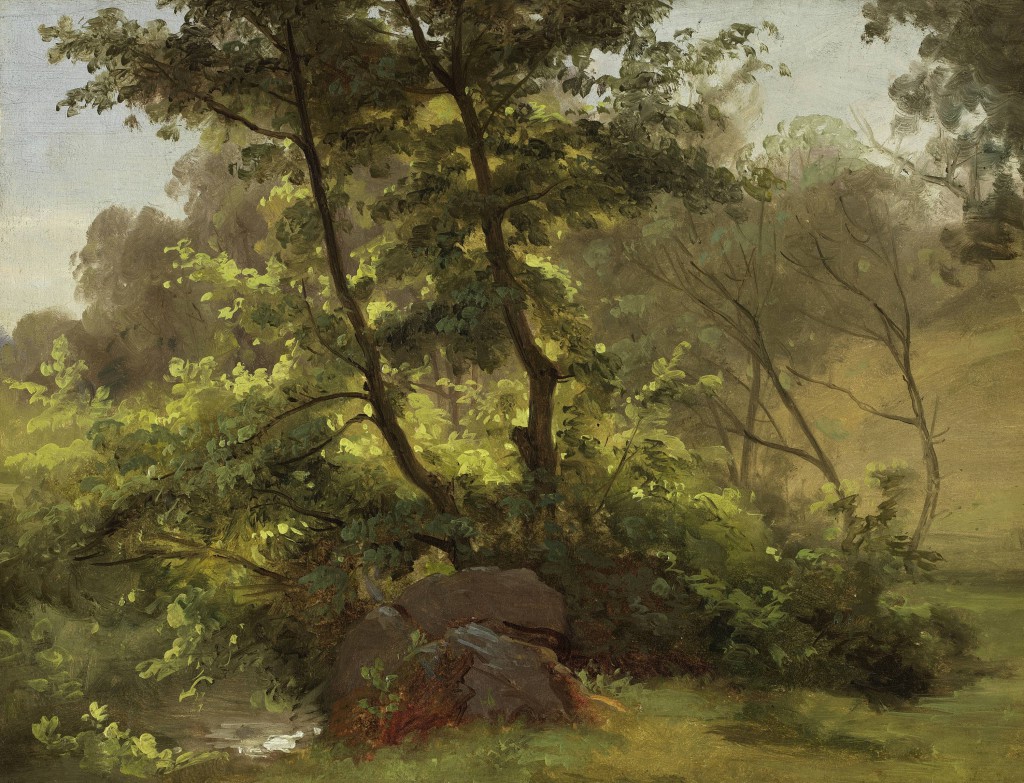Christian Friedrich Gille (Ballenstedt 1805 - 1899 Dresden)
Underbrush by a Stream, Dresden c.1830/35
Oil on paper, laid down on cardboard, 25.4 x 33.2 cm
Annotated on the verso in pencil Gille
Authenticated by Mr. and Mrs. Spitzer
The present oil study by Christian Friedrich Gille can be dated to the early 1830s. Stylistically it is closely related to the oil sketches titled Tree Crowns set against a Blue Sky, executed c.1834 and Garden which is dateable to around 1835 [1]. These studies, in contrast to Gille's earlier studies of groups of trees, show a move towards a looser, more economic handling of the motif in a style independent of traditional convention. Areas of direct light serve to model forms. Contours are sharpened and in half shadow and shade they soften and seem to dissolve. The same effect is present in an oil sketch of the same period titled Parkland [2].
Gille, who had studied under Johan Christian Dahl, came to be regarded as one of the leading exponents of plein-air painting of his era. His preferred subjects were small, unspectacular scenes captured directly before the motif. He worked mainly in Dresden and its surroundings and today, art historians rank him at the forefront of Romantic painting in Dresden. He is now regarded as a key contributor to the development of a strain of unsentimental realism in landscape painting.
As Hans Joachim Neidhardt writes: Gille is the most important of all Johan Christian Dahl's pupils and the one to have gone far beyond the tenets of his teacher. When Gille started work in Dahl's studio in 1827, Dahl had only recently returned from his extended and highly eventful study trip to Norway. [... ]. Drawing on the example of Dahl's oil studies after nature and their fluidity and idiosyncratic, economic style, Gille went on to develop his own free, fluid style of brushwork. Unlike Dahl, he regarded the studies he executed before nature not as preparatory to larger-format oils but as paintings in their own right. Gille's small landscape sketches - the rediscovery and conservation of which are largely thanks to the Dresden collector Friedrich Lahmann - display the full force of his colouristic virtuosity and his elementary delight both in the painting process and in the subject itself. Working in the tradition of Dahl, he advanced to become the painter of Dresden landscapes par excellence, interpreting the characteristics of the region with extraordinary sensibility. He shared with Dahl and Carus an intense interest in weather effects, as an important body of his cloud studies documents. What makes these landscape studies so important from an art-historical viewpoint is the new aesthetic approach that inspired them. It springs from a desire to capture in rapid brushstrokes the fleeting experience of a visual impression[3].
Herrmann Zschoche (Schwenow, Brandenburg) has examined the painting and confirms the attribution to Gille. Inscriptions similar to the one on the verso of the present painting are familiar to him from a number of other studies by the artist. In his opinion the name Gille was inscribed on the verso when the artist's estate was being inventoried.
Herr and Frau Gerd Spitzer (Dresden) have provided verbal confirmation of the attribution and dating.
[1] Gerd Spitzer (ed.), Christian Friedrich Gille 1805-1899, exhib. cat., Dresden, Staatliche Kunstsammlungen and Bremen, Kunsthalle, 1994-5, Leipzig 1994, nos. 17 and 19.
[2] Im Parkgrund, Leipzig, op. cit., no. 10.
[3] Von allen Schülern Johan Christian Dahls ist Gille der bedeutendste. Er ist am weitesten über seinen Lehrer hinausgegangen. Als er 1827 in Dahls Atelier eintrat, war jener gerade von seiner so ergebnisreichen Reise durch Norwegen zurückgekehrt. ... Gille knüpfte an Dahls Naturstudien an und entwickelte aus der Lockerheit ihrer abkürzenden Pinselschrift seinen eigenen breiten Malstil. Er sah, im Gegensatz zu Dahl, seine vor der Natur geschaffenen Studien nicht als Vorarbeiten zu größeren Gemälden an, sondern malte sie um ihrer selbst willen. In seinen besonders durch den Dresdner Sammler Friedrich Lahmann wiederentdeckten und bewahrten Landschaftsbildchen äußert sich ein starkes koloristisches Temperament, eine elementare Freude am Malvorgang und natürlich auch am Motiv. Gille wurde in der Nachfolge Dahls zum eigentlichen Maler der Dresdener Landschaft, die er mit tiefem Verständnis für die Eigenart einfühlsam interpretierte. Dabei verbindet ihn das lebhafte Interesse an atmosphärischen Erscheinungen, das durch zahlreiche Wolkenstudien belegt ist, mit Dahl und Carus. Was diese Landschaftsstudien kunstgeschichtlich so bedeutsam macht, ist die neuartige ästhetische Einstellung, aus der heraus sie entstanden sind. Es ist das Streben, das schnell Vergängliche eines optischen Eindrucks mit raschem Pinsel festzuhalten, Hans Joachim Neidhardt, Die Malerei der Romantik in Dresden, Leipzig 1976, p.191 f.

